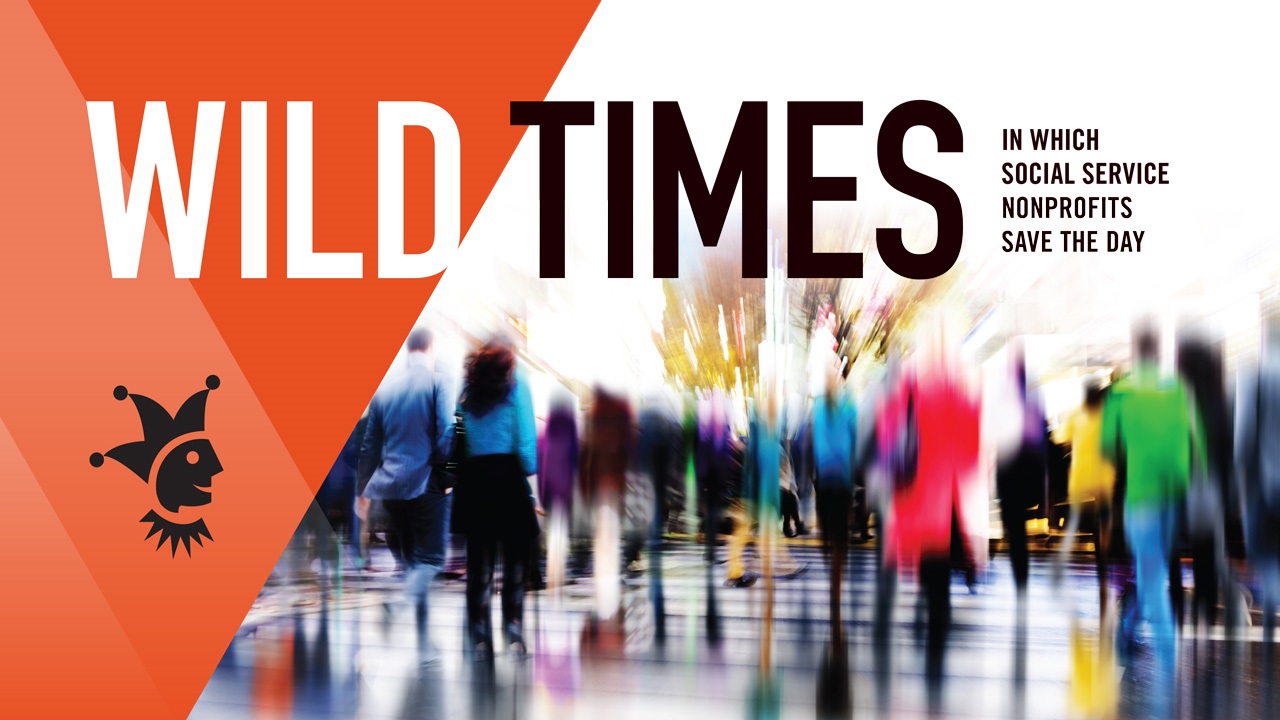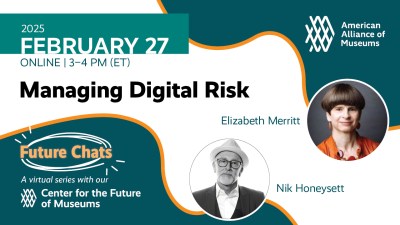
Introduction to This Scenario
A wild card scenario explores the kind of low-probability, high-impact event that can disrupt the best-laid plans. Though you shouldn’t obsess about these possibilities, including a few wild cards in your planning deck will help you prepare to respond should the best or worst occur. As you consider how you could handle these disruptions, you may discover actions that improve your organization’s performance whether or not a particular wild card comes into play. (Wild Times is the fourth and final scenario created for TrendsWatch 2018. Access all the scenarios here, and watch for the publication of the compiled set, together with a discussion guide, by the end of the year.)
When I invited museum people to brainstorm wild cards for our scenario set, their ideas varied in tone from blazingly bright (the federal government establishes a fund that provides operating support to all US museums) to pitch black (a meteor strike wipes out the majority of life on earth). However, it’s important to consider not just the probability and impact of a wild card event, but also utility. When choosing a wild card for your planning, ask, “How can contemplating this possibility make us better prepared for the future?” Applying those criteria to our whole sector, I selected a wild card that has long piqued my curiosity: What if cultural nonprofits collectively lost their nonprofit status?
Loss of nonprofit status would certainly be high impact, and thankfully it is highly improbable as well. This particular wild card is worth considering because it raises issues many organizations should be confronting in any case. A scenario based on this wild card can lead planners to:
- Develop a more entrepreneurial approach to financial planning. All too often, our field operates as if “nonprofit” were a business strategy rather than a tax status. By temporarily setting aside the not-for-profit label, museum leaders can stimulate creative thinking about how their organizations can develop new sources of income, enabling them to do more and better mission-driven work.
- Become sensitized to signals that may presage more circumscribed versions of this wild card. While the extreme version of this story is highly improbable, the advantages of tax-exempt status are already being eroded in many cities and states through the imposition of fees or payments in lieu of taxes, or the removal of local or state tax exemptions. Recent changes in tax policy have resulted in fewer incentives for charitable donations, and many mega-donors are directing the vast majority of their giving to health and education causes rather than to arts and culture. (See more on these trends in the Signals section, below.)
- Revisit their value proposition. All organizations should be able to articulate who benefits from their work and how. Documenting the shared public benefits of an organization’s work builds the case for broad public support. Identifying particular segments of the public, government, or business community that enjoy specific benefits may lead to creative thinking about other types of financial support. Thinking beyond admissions revenue and traditional philanthropy, some nonprofits are beginning to build value around relationships in other ways, from social impact bonds to fees for service.
- Raise awareness of the need to engage in state and national advocacy. The best way to future-proof the nonprofit status of museums is to document the benefits we provide, collect and share compelling stories of the difference we make in the world, and build ongoing relationships with local, state, and federal legislators.
- Recognize that there are emerging business models, including for-profit, social enterprise, and benefit corporation status, that may be viable alternatives for museums in the future.
Overview of This World in 2040
This synopsis provides a high-level description of the year 2040 with respect to culture, technology, the economy, ecology, and policy.
America has a large and thriving nonprofit community consisting primarily of organizations (both secular and religious) devoted to meeting basic human needs. These organizations play a crucial and valued role in housing, food security, employment training, and community health services. They receive generous operating subsidies from the government, and all donors are eligible for a universal charitable deduction on their federal tax returns.
A time traveler from the 20th century would be surprised at the notable organizations missing from this national nonprofit roster, including the Society for the Prevention of Cruelty to Animals, the Girl Scouts, the Nature Conservancy, UNICEF, Planned Parenthood, and the American Alliance of Museums. In fact, by 2040, only entities dedicated to health and human services are eligible for federal tax-exempt status. Many states and municipalities, taking their lead from the federal government, have also tightened restrictions on what types of organizations qualify for property and sales tax exemptions.
This huge shift in the makeup of America’s nonprofits was the result of the national Nonprofit Reform Act of 2035, which radically redrafted the boundaries of the charitable sector. We can trace the origin of the act to the virulent partisan debates leading up to the 2032 presidential election. The victorious candidate had campaigned on a platform of minimalist government. One component of this platform was a call for nonprofit reform that was essentially a rhetorical device for criticizing federal tax policy and federal spending. This abstract proposal became very real, however, when the new president was faced with two crises shortly after taking office. In the fall of 2033, the corporate debt bubble burst, triggering the largest economic downturn in the history of the industrial era. Come winter, the global pandemic of Geriatric Respiratory Syndrome arrived in the US via international travelers. While GRS had mercifully low mortality rates, it left 20 percent of survivors over the age of 65 in need of long-term, full-time home care.
Rallying in the face of these disasters, elected officials set aside partisan concerns and united around efforts to provide effective relief. Polls showed massive popular support for a larger federal role in repairing and extending the social safety net in the wake of the double disaster, including extended unemployment payments, job retraining, support for family caregivers, and the creation of a national home health service corps. The president, trying to balance her campaign promises with this demand for government action, turned to social service nonprofits as major partners in meeting these needs. The most effective role for government, she argued, was to channel public moneys to the charitable sector via both tax policies and direct funding. The push for nonprofit reform was revived, this time as a mechanism for concentrating government and philanthropic support where it was most needed.
Economists and policy analysists are still trying to untangle the effects of the reform. It is well documented that social service nonprofits rose to the challenge and have been doing a tremendous job supporting the needs of their communities during the long, slow process of recovery. But the reform was devastating for that segment of the charitable sector that lost its nonprofit status. Some organizations reinvented themselves and converted to new business models. Many small, community-based organizations that lost nonprofit status found that the people who valued their work were still willing to donate time, materials, and money. Some became benefit corporations, retaining their legal obligation to deliver on their missions while remaining eligible for some kinds of foundation funding. But many former nonprofits simply folded. It is estimated that as many as 250,000 organizations, large and small, declared bankruptcy or suspended operations in the years following reform.
The nonprofit purge may actually have hampered economic recovery and amplified individual and community trauma. The failure of so many organizations added 8 million workers to the rolls of the unemployed, with another 8 million layoffs from for-profit business attributed to downturns in travel, tourism, retail, and support services. Estimates of the economic damage from lost wages, direct revenue, and taxes associated with travel and tourism range from $20 billion to $200 billion. And many people feel that the loss of these valued organizations damaged the resilience of communities when they were most in need of social connections, inspiration, and joy.
Signals
Although wild cards often seem to come out of the blue, seismic events are sometimes presaged by foreshocks—small rumblings that warn of what may come. Here is a selection of real news stories and research from the present that are faint signals of the major disruption at the heart of this scenario.
On erosion of the benefits of tax-exempt status
The Lincoln Institute of Land Policy’s 2016 brief Nonprofit PILOTS (Payments in Lieu of Taxes) notes that local governments waive about 4 to 8 percent of their property tax revenue each year due to exemptions for charitable nonprofits. In response, 218 localities in 28 states have imposed PILOT payments that generate over $92 million in revenue each year. While hospitals and institutions of higher education bear the brunt of these fees, many smaller nonprofits, including museums, have been affected as well.
On differential treatment of segments of the nonprofit sector
The US House of Representatives version of a 2019 appropriations bill currently under negotiation revises the Johnson Amendment, a provision of the federal tax law that bars nonprofits from endorsing candidates for public office and engaging in partisan electioneering activities. The controversial rider would exempt churches (but not other nonprofits) from this long-standing ban. (The proposal has met with condemnation from a wide variety of nonprofit organizations, and a national poll showed that 72 percent of American voters supported the current blanket prohibition on partisan political activity by nonprofits.)
The 2016 U.S. Trust Study of High Net Worth Philanthropy found that 63 percent of wealthy donors give to charities providing basic necessities, while only 26.8 percent support arts and culture. (This translates to almost 28 percent of high net worth dollars going to support basic needs, with 4.6 percent going to arts and culture.) The 2018 report Arts Funding at Twenty-Five: What Data and Analysis Continue to Tell Funders about the Field, commissioned by Grantmakers in the Arts, documents how the pressure to meet basic human needs is shrinking the percentage of US foundation funding dedicated to arts and culture.
On public preparedness to defend nonprofits
In a recent analysis of data from the National Awareness, Attitudes, and Usage Study, researcher Colleen Dilenschneider found that over half of both non-visitors and visitors to nonprofit cultural organizations are not aware that these entities are nonprofits. If the public does not know that museums are nonprofit organizations (or what that means), how can they be expected to defend policies that establish and maintain the nonprofit sector?
Discussion Guide
Reality Check
This scenario is deliberately premised on a low probability event. Your challenge is not to quantify exactly how probable it is, but to identify what signs could warn us that this scenario is becoming more likely as time goes on. As you read the news in coming weeks, keep your eyes open for signals of trends or events that could lead us towards some version of this future.
Agree/Disagree
While this wild card is broadly applicable to all cultural nonprofits, it may not be the improbable event of greatest concern to your organization. In your planning process, include some time for participants to brainstorm a list of the low-probability, high-impact events they feel are most significant for your circumstances. You may find it useful to develop your own scenario around one or more of these wild cards.
Here are a few other wild cards suggested by CFM’s brainstorming group:
- A major donor decides to divert critical support to another institution.
- An earthquake of 7.0 or greater devastates the local community/region. (This risk is of particular relevance to organizations sited near major geologic fault lines such as the New Madrid fault in the Southern and Midwestern US, the San Andreas and Hayward faults on the Pacific coast, and the Cascadia fault in the Pacific Northwest.)
- A major cyberattack targets global internet infrastructure and malware spread via cloud-integrated systems destroys 90 percent of all digital assets and commerce.
- Global tourism collapses due to curbs established to contain terrorism and the spread of pandemic disease. (Some people suggested events that could significantly damage domestic tourism in particular communities as well.)
Museums in This Future
What are some of the implications of this future for museums? Here are some thoughts to get you started, along with notes on how these issues may pertain to more probable futures:
- In the present, museums on average have seven volunteers for each paid staff member. In this scenario, museums may lose this labor force if people are unwilling to volunteer their time to organizations that are not non-profit. If volunteerism does decline, how will museums adapt? The Bureau of Labor Statistics has already documented a slow decline in the rate of volunteerism in the US. Trends such as more people needing to hold multiple jobs, a rising number of single parent households, and older workers delaying retirement may make it harder for people to volunteer in coming decades.
- In this future, absent a tax incentive, will people still be willing to donate money and collections to museums? Thirty percent of taxpayers currently itemize deductions on their returns, but recent changes in tax law could drop that number to 10 percent. (The American Alliance of Museums is advocating for the passage of a universal charitable deduction to incentivize giving.)
- In this future, might some museums retain their nonprofit status because of their focus on community health and human services? Think about what that museum might look like. Are there museums that fit that profile today?
- What legal structures, other than nonprofit status, could foster the nonprofit missions of museums? Consider, for example, the rise of benefit corporations and low-profit limited liability companies (L3Cs)—forms of incorporation that legally obligate a company to deliver both social/environmental and economic returns to their investors. We are also seeing an increase in the number of for-profit companies becoming certified as B corporations, a form of voluntary third-party verification documenting how the company balances profit with social and environmental performance, public transparency, and legal accountability.
From Insight to Foresight
Exploring scenarios helps us future-proof plans by asking, “How, in this future, would I/my family/my community/my museum thrive?” By answering this question across several scenarios, you may identify actions that would be beneficial in a variety of circumstances.
In this future I might:
In this future my organization might:
From Foresight to Action
This scenario could result from trends and events we see in the world today. But always remember the third force creating the future: the choices that we make as individuals and as organizations. The most important part of this exercise is discovering how you can help build the future in which you want to live. As you explore the implications of this scenario, consider the following questions.
To help avoid this future I might:
- Engage in local, state, and national advocacy to support the museum field. Attend Museums Advocacy Day!
To help avoid this future my organization might:
- Document the economic and community impact of my organization’s work. (See, for example, the impact reports prepared by the Detroit Zoo.)
In particular, it would be valuable for all who work in and around the museum sector to ask ourselves, “How can we foster the public’s understanding and appreciation of how their lives are better because of museums, such that it would be unthinkable to withdraw support from museums?”









Great piece Elizabeth. Always inspiring and insightful to read your work. I had just read the blog post from Colleen Dilenschneider and was thinking the same issue about visitors being unaware of the nonprofit status and what it means, etc. This seems like an interesting area for institutions to work better to identify who they are and how they may communicate that to visitors. For instance, we at Vizcaya are evolving our identity and hope to play a stronger more relevant role in the community as it relates to sustainability and resiliency. How we communicate this to the public and how this relates to our nonprofit status can be important strategic decisions in how the community finds value in who we are.